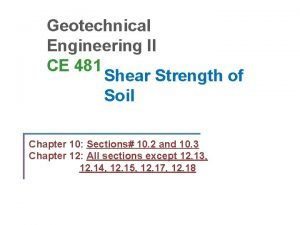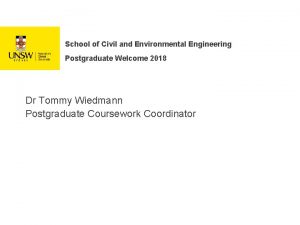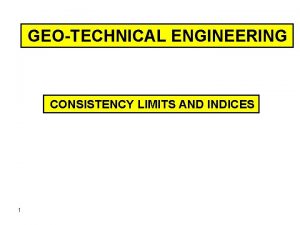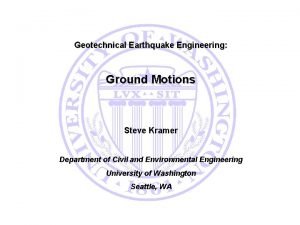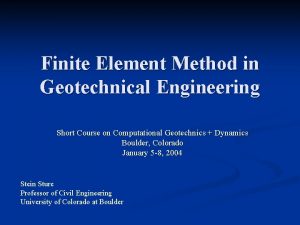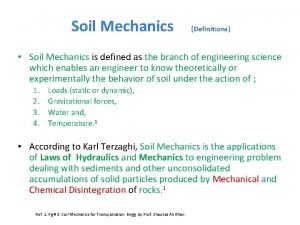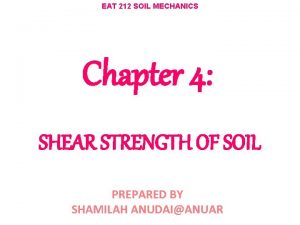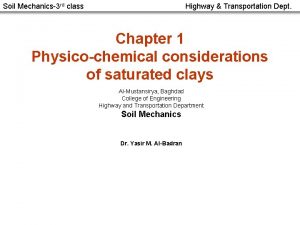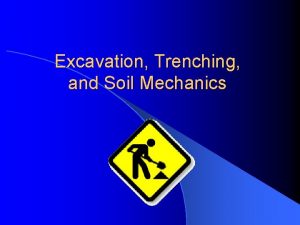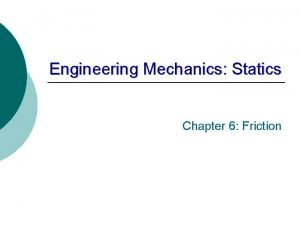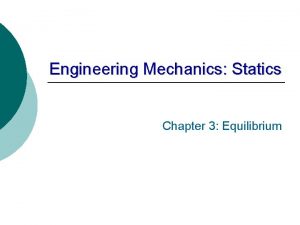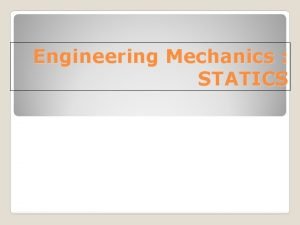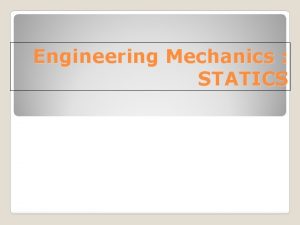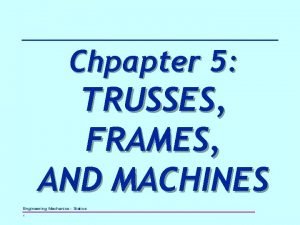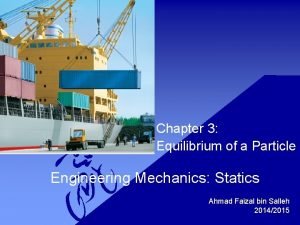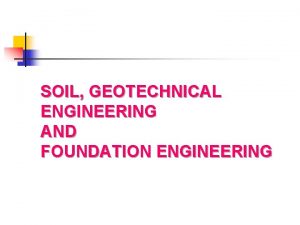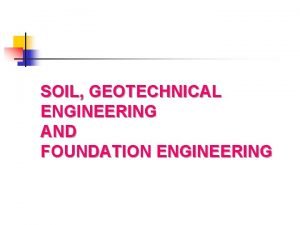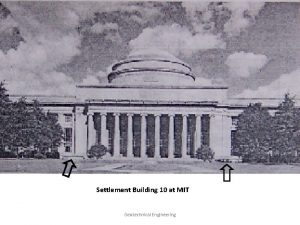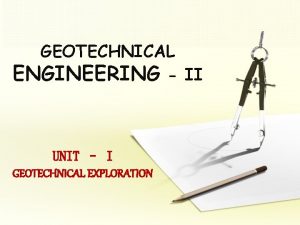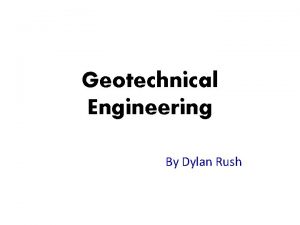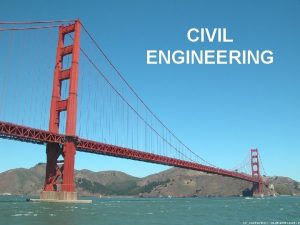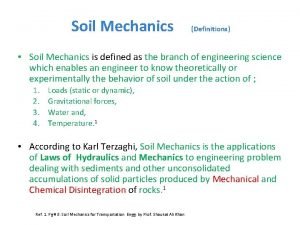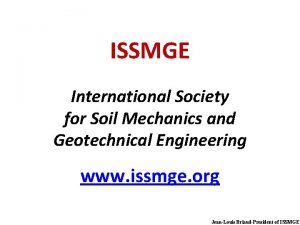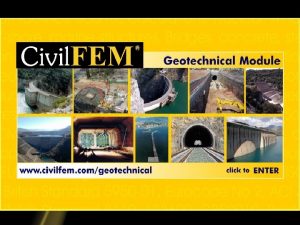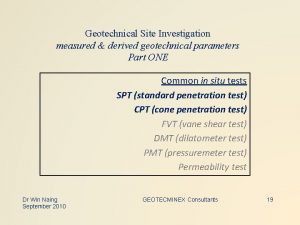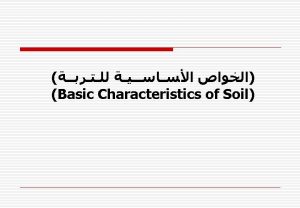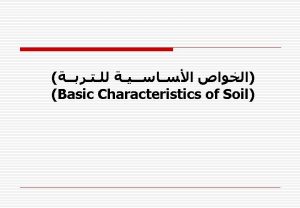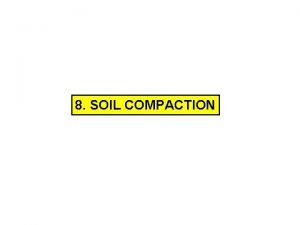Geotechnical Engineering Soil Mechanics Mr Sainand Khot Asst


























- Slides: 26

Geotechnical Engineering/ Soil Mechanics Mr. Sainand Khot Asst. Professor DYPIEMR, Akurdi-44

Geo Technical Engineering • Meaning of geotechnical ? • What it has to do with engineering ? • Relation with civil engineering ? • Why it is called the mother of civil engineering ? By Mr. Sainand Khot DYPIEMR, Akurdi-44

Railways By Mr. Sainand Khot DYPIEMR, Akurdi-44

Roadways By Mr. Sainand Khot DYPIEMR, Akurdi-44

Foundation Failure By Mr. Sainand Khot DYPIEMR, Akurdi-44

Mining Engineering Failure By Mr. Sainand Khot DYPIEMR, Akurdi-44

Structural Failure due to Liquefaction By Mr. Sainand Khot DYPIEMR, Akurdi-44

Videos • Embankment failure due to the seepage flow and overburden pressure • Foundation failure By Mr. Sainand Khot DYPIEMR, Akurdi-44

Answers • Soil mechanics or geotechnical engineering is the application of laws of mechanics & hydraulics to engineering problems dealing with sediments and other unconsolidated accumulations of solid particles produced by the mechanical and chemical disintegration of rocks By Mr. Sainand Khot DYPIEMR, Akurdi-44

Applications in Civil Engineering 1. Foundation Design and Construction • Calculations of bearing capacity • Pattern of stress distribution under load • Settlement of foundation • Effect of ground water & vibrations • Suitability of foundation • Shrinkage & swelling characteristics By Mr. Sainand Khot DYPIEMR, Akurdi-44

2. Pavement Design • Type of pavement (rigid/flexible) • Thickness of subsoil • Consequent fatigue failure & effect of repetition of loading has to be taken in consideration of high intensity traffic By Mr. Sainand Khot DYPIEMR, Akurdi-44

3. Design of underground structures & earth retaining structures • Soil structure interaction is essential to design 4. Design of embankment & excavation • Shear strength & related By Mr. Sainand Khot DYPIEMR, Akurdi-44

5. Design of earth dams • Determination of soil properties like index properties, such as density, plasticity, specific gravity, particle size distribution and gradation of soil, permeability, consolidation and By Mr. Sainand Khot DYPIEMR, Akurdi-44

Types of Soil structure By Mr. Sainand Khot DYPIEMR, Akurdi-44

Major soil deposits of India Based on the climatic conditions, topography & geology of their formation following are the classifications • Alluvial Soils • Black Cotton Soils • Laterites and By Mr. Sainand Khot DYPIEMR, Akurdi-44 lateritic Soils

Alluvial Soils • formed mainly due to silt deposited by Indo-Gangetic. Brahmaputra rivers • They are immature and have weak profiles due to their recent origin • soil is porous because of its loamy (equal proportion of sand clay) nature • Porosity and texture provide good drainage and other conditions favorable for agriculture. • These soils are constantly By Mr. Sainand Khot DYPIEMR, Akurdi-44 replenished by the recurrent

Black Cotton Soils • parent material for most of the black soil are the volcanic rocks that were formed in the Deccan Plateau • These are the region of high temperature and low rainfall. It is, therefore, a soil group typical to the dry and hot regions of the Peninsula • black soil is highly argillaceous with a large clay factor, 62 per cent or more • black soils of uplands are of low fertility while those in the valleys are very fertile • black soil is highly retentive of moisture. It swells greatly on By Mr. Sainand Khot DYPIEMR, Akurdi-44 accumulating moisture

Laterites & lateritic Soils • Laterite soils are mostly the end products of weathering • formed under conditions of high temperature and heavy rainfall with alternate wet and dry periods. • Continuous stretch of laterite soil is found on the summits of Western Ghats at 1000 to 1500 m above mean sea level, Eastern Ghats, the Rajmahal Hills, Vindhyan, Satpuras and Malwa Plateau • They are well developed in south Maharashtra, parts of Karnataka By Mr. Sainand Khot DYPIEMR, Akurdi-44 etc.

Desert Soils • desert soils consist of Aeolian sand (90 to 95 per cent) and clay (5 to 10 per cent). • presence of sand inhibits soil growth. Desertification of neighboring soils is common due to intrusion of desert sand under the influence of wind • ccur in arid and semi-arid regions of Rajasthan, Punjab and Haryana. By Mr. Sainand Khot DYPIEMR, Akurdi-44

Marine Soils • Marine deposits are sediments that accumulate in a marine (ocean or sea) environment. • Marine deposits are predominantly of clay size (occasionally may contain some shells), very well sorted, devoid of coarse particles, and usually unstratified (show no layers). • These soils are found in narrow belt near the south. By Mr. Sainand Khot DYPIEMR, Akurdi-44

Field Identification of soils By Mr. Sainand Khot DYPIEMR, Akurdi-44

By Mr. Sainand Khot DYPIEMR, Akurdi-44

By Mr. Sainand Khot DYPIEMR, Akurdi-44

Soil Explorati • Objective: on To provide reliable, specific and detailed information about the soil and ground water conditions of the site which may be required • Purpose: for a safe and economic design and execution of the engineering work. • (i) To determine the basic properties of soil which affect the design and safety of structure i. e. , compressibility, strength and hydrological conditions. By Mr. Sainand Khot DYPIEMR, Akurdi-44

Different stages of sub-soil investigation of a major civil Engineering project • (i) Reconnaissance study: • (a) Geological data • (b) Serial photographs • (C) Pedological data • (ii) Detailed investigation: • (a) Boring • (b) Sampling • (c) Testing • • (i) Lab test (ii) Field test (d) Aerial photographs (e) Geophysical methods (iii) Performance study (a) Further testing (b) Instrumentation (c) Performance evaluation By Mr. Sainand Khot DYPIEMR, Akurdi-44

Thank You By Mr. Sainand Khot DYPIEMR, Akurdi-44
 Uu test mohr circle
Uu test mohr circle Unsw geotechnical engineering masters
Unsw geotechnical engineering masters Applied geotechnical engineering
Applied geotechnical engineering Consistency limits in geotechnical engineering
Consistency limits in geotechnical engineering Geotechnical engineering
Geotechnical engineering Geotechnical earthquake engineering kramer
Geotechnical earthquake engineering kramer Fem geotechnics
Fem geotechnics Construction management swinburne
Construction management swinburne Geotechnical data management
Geotechnical data management Geotechnical data management
Geotechnical data management Living soil vs dead soil
Living soil vs dead soil What are the four spheres of the earth
What are the four spheres of the earth Soil mechanics definition
Soil mechanics definition Critical state soil mechanics for dummies
Critical state soil mechanics for dummies Non cohesive soil
Non cohesive soil Soil mechanics
Soil mechanics Hydraulic conductivity of soil formula
Hydraulic conductivity of soil formula 1926 excavation
1926 excavation Pearson education south asia pte ltd
Pearson education south asia pte ltd Friction in engineering mechanics
Friction in engineering mechanics Statics chapter 3
Statics chapter 3 Engineering mechanics statics chapter 2 solutions
Engineering mechanics statics chapter 2 solutions Centre of gravity engineering mechanics
Centre of gravity engineering mechanics Center of gravity statics
Center of gravity statics What is equilibrium in engineering mechanics
What is equilibrium in engineering mechanics Trusses and frames
Trusses and frames Particle equilibrium in 2d and 3d engineering mechanics
Particle equilibrium in 2d and 3d engineering mechanics
